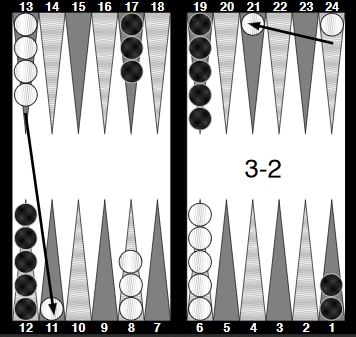Last updated on June 14, 2024
In this Deluxe Backgammon post for beginners, we are going to take a closer look at the 3-2 opening roll. The 13/8 move is the most favoured by beginners and many intermediates. It is very safe and moves another builder down to the 8-point. However, computer rollouts have shown this to be one of the least effective ways to play this roll. This is because it simply just adds to the stack on the 8-point and doesn’t do anything constructive to develop the board. This means it does nothing to increase the flexibility for subsequent moves.
Additionally, some other players may be tempted to slot the 5-point by playing the 3 from the 8-point. This play should also be disregarded as it strips the 8-point. This means that if you want to use a checker from your 8-point, either to secure the bar-point or the five-point, a blot will need to be left on the 8-point.
The 3-2 is not the most inspiring opening move. Ideally, you would get a roll that allows you to secure a key point or escape one of your back checkers, such as with a 6-5 opening. These are not an option on the 3-2 opening. However, the 3-2 provides opportunities to develop the checker structure to create flexibility on subsequent rolls.
The two most popular ways to play this roll are:
- 24/21, 13/11 (splitting the back checkers with the 3 and bringing down a builder with the 2).
- 13/11, 13/10 (bringing down two builders into the outer board).
24/21, 13/11
Splitting the back checkers using the 3 creates advantages and disadvantages. If the blot isn’t hit it provides an opportunity to secure an advanced anchor on the opponent’s 4-point. This creates a secure point in the opponent’s home board which is a safe place to land if hit. It also prevents the opponent from building an effective home board prime. The disadvantage of this splitting play is that the 4-point is one of the most valuable locations on the board and the opponent will almost certainly hit if they do get the chance. A hit would not be a total disaster, as very little ground is lost and there is plenty of time to recover.
On the other side of the board, the 2 is used to bring a builder down from the heavily stacked mid-point. Unstacking is always a good idea early in the game as it frees up checkers to be better used elsewhere on the board. The blot on the 11-point is relatively safe from being hit It is only reachable by a 6-4 roll, which occurs on 2 out of 36 (6%) possible rolls on the opponent’s reply. The builder can be used to secure the bar-point or 5-point on subsequent rolls. It provides an attacking option in the outer board in case the opponent tries to run one of the back checkers.
13/11, 13/10
The 13/11, 13/10 move is an aggressive play. It brings two builders down from the heavily stacked mid-point. These builders can be used on subsequent rolls to secure key points, such as the bar-point and the 5-point. The goal with this opening play is to start building blocking points that will prevent your opponent from running with their back checkers. Ideally, these blocking points will help construct a prime in the later stages of play.
There is some risk with this play, as it leaves two blots in the outer board that can be hit. In the opening reply, rolls of 6-4, 6-3, 5-4 and 3-3, bring those blots in range. These rolls occur on 7 out of 36 (19%) possible replies. Hitting on these rolls is a good option for your opponent as it triggers a running strategy with one back checker escaping and your blot on the bar.
XG Mobile Backgammon rollouts show that there is barely any advantage to either of these plays. The best thing to do is to experiment with both and choose the move that suits your style of play. The 24/21, 13/11 is the more defensive of the two plays and is likely to suit more conservative players. However, the 13/11, 13/10 is more offensive and is likely to suit those with an attacking style. Remember, whatever move you make, avoid reverting to the wasteful 13/8 option.
Related content
Backgammon opening theory at Wikipedia.
A simple list of opening moves.
Backgammon opening moves, a detailed list.
Read about the general principles for replying to the opening moves.



Those moves seem risky, too much chance of being hit. if my opening roll is 3-2, I take the riskless option of 13/8. It doesn’t seem to affect my chances of winning at backgammon.
Hi Ray, the chances of being hit are fairly low for both moves, 6% and 19% respectively. If you have a bad run of luck, it might seem like you are getting hit all of the time. If you tracked the numbers over time, I am sure you would only be getting hit according to the percentages above. There is a lot of psychology in backgammon, a run of bad lurk can force you to play too defensively. The recommended moves above, are all about taking calculated risks in order to create more options on subsequent rolls. Besides, taking a risk early in a game of backgammon, gives you time to recover. Learn some basic probability and take some calculated risks, it will pay off in the long run. Thanks for taking the time to comment, Jason